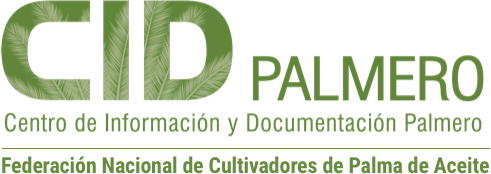Effect of Fruit Ripening on Content and Chemical Composition of Oil from Three Oil Palm Cultivars (Elaeis guineensis Jacq) Grown in Colombia (J. Agric. Food Chem. 2011, 59, 10136–10142)

Author
Prada, Fausto
Ayala-Díaz, Iván M.
Delgado, Wilman
Ruiz-Romero, Rodrigo
Romero, Hernán M.
Estadisticas
Publicación:
Revista Palmas; Vol. 33 Núm. 2 (2012); 25-39
0121-2923
Revista Palmas; Vol. 33 Núm. 2 (2012); 25-39
0121-2923
Abstract
A series of physical and chemical changes occur as oil palm fruits ripen in the bunch. We evaluated changes in lipid content in the mesocarp and fruits, and the chemical composition of fatty acids (FA), triacylglycerol (TAG), tocols, and carotenes of the lipids extracted from fruits of three commercial Tenera cultivars, namely, Deli x La Mé, Deli x Ekona, and Deli x Avros, planted in two different geographical regions in Colombia, during the ripening process 12, 14, 16, 18, 20, 22, and 24 weeks after anthesis (WAA). It was found that 12 WAA the mesocarp contained less than 6% of total lipids. Oil content increased rapidly after 16 WAA, reaching the maximum oil content of 55% in fresh mesocarp and 47% in fresh fruits at 22 WAA, which was found the optimal time for harvesting. Changes in FA and TAG showed that total polyunsaturated fatty acids (PUFA) and triunsaturated triacylglycerols (TUTAG) decreased, while total saturated fatty acids (SFA) and disaturated triacylglycerols (DSTAG) increased, over the ripening period. Changes in FA were mainly observed in palmitic, oleic, linoleic, and linolenic acids, and in POP, POO, POL, and OLL for the TAGs evaluated. Levels of tocols changed depending on whether they were tocopherols or tocotrienols. In the earliest stages tocopherols were predominant but decreased rapidly from 6600 mg kg-1 of oil at 14 WAA to 93 mg kg-1 of oil at 22 WAA. Tocotrienols appeared at the same time as oil synthesis started, and became the main source of total tocols, equivalent to 87% in total lipids extracted. Cuando los racimos de la palma de aceite se maduran se presentan una serie de cambios físicos y químicos en el fruto. Este estudio evaluó los cambios en la cantidad de lípidos (aceite) en el mesocarpio y los frutos, la composición química de ácidos grasos (AG), triacilgliceroles (TAG), tocoles y carotenos en los lípidos extraídos de frutos de tres materiales comerciales Ténera: Deli x La Mé, Deli x Ekona y Deli x Avros, plantados en dos localidades de Colombia. Las evaluaciones se realizaron durante el proceso de maduración a las 12, 14, 16, 18, 20, 22 y 24 semanas después de la antesis (SDA). Se encontró que en las 12 SDA el mesocarpio contenía menos de 6% de lípidos totales. El contenido de aceite aumentó rápidamente después de las 16 SDA, alcanzando el máximo de 55% en el mesocarpio fresco y 47% en los frutos frescos a las 22 SDA, considerado como el tiempo óptimo para la cosecha. Los cambios en los AG y en los TAG mostraron que los ácidos grasos poliinsaturados (PUFA) y los triacilgliceroles triinsaturados (TUTAG) disminuyeron, mientras que el total de los ácidos grasos saturados (SFA) y triacigliceroles disaturados (DSTAG) aumentaron durante el período de maduración. Los cambios en los AG se observaron principalmente en los ácidos linolénico, linoleico, oleico y palmítico y en POP, POO, POL y OLL para los TAG evaluados. Los niveles de tocoles cambiaron dependiendo de si estos eran tocoferoles o tocotrienoles. En las primeras etapas de evaluación, los tocoferoles predominaban pero disminuyeron rápidamente pasando de 6600 mg kg-1 de aceite en las 14 SDA a 93 mg kg-1 de aceite en las 22 SDA. Los tocotrienoles aparecieron en el inicio de la síntesis del aceite y se convirtieron en la fuente principal de tocoles al final de proceso de maduración, equivalente a 87% del total presente en el aceite.
A series of physical and chemical changes occur as oil palm fruits ripen in the bunch. We evaluated changes in lipid content in the mesocarp and fruits, and the chemical composition of fatty acids (FA), triacylglycerol (TAG), tocols, and carotenes of the lipids extracted from fruits of three commercial Tenera cultivars, namely, Deli x La Mé, Deli x Ekona, and Deli x Avros, planted in two different geographical regions in Colombia, during the ripening process 12, 14, 16, 18, 20, 22, and 24 weeks after anthesis (WAA). It was found that 12 WAA the mesocarp contained less than 6% of total lipids. Oil content increased rapidly after 16 WAA, reaching the maximum oil content of 55% in fresh mesocarp and 47% in fresh fruits at 22 WAA, which was found the optimal time for harvesting. Changes in FA and TAG showed that total polyunsaturated fatty acids (PUFA) and triunsaturated triacylglycerols (TUTAG) decreased, while total saturated fatty acids (SFA) and disaturated triacylglycerols (DSTAG) increased, over the ripening period. Changes in FA were mainly observed in palmitic, oleic, linoleic, and linolenic acids, and in POP, POO, POL, and OLL for the TAGs evaluated. Levels of tocols changed depending on whether they were tocopherols or tocotrienols. In the earliest stages tocopherols were predominant but decreased rapidly from 6600 mg kg-1 of oil at 14 WAA to 93 mg kg-1 of oil at 22 WAA. Tocotrienols appeared at the same time as oil synthesis started, and became the main source of total tocols, equivalent to 87% in total lipids extracted.
Palabras clave:
HPLC
lipids
triacylglycerol
fatty acids
tocols
carotenoids
palm oil
HPLC
lípidos
triacilglicerol
ácidos grasos
tocoles
carotenos
aceite de palma
HPLC
lipids
triacylglycerol
fatty acids
tocols
carotenoids
palm oil
HPLC
lípidos
triacilglicerol
ácidos grasos
tocoles
carotenos
aceite de palma


